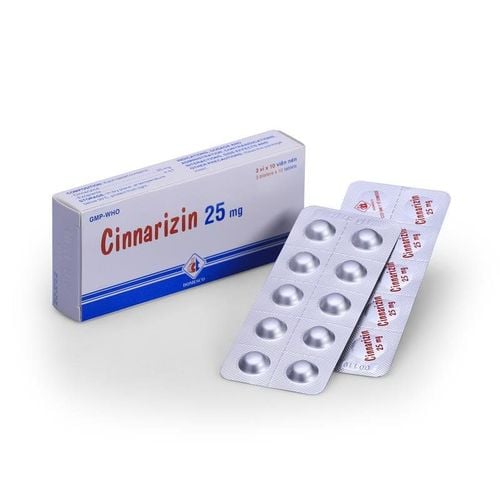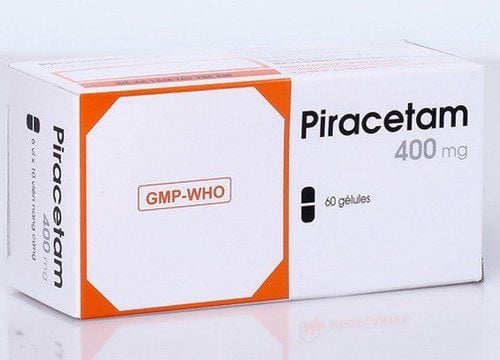This is an automatically translated article.
Piracetam is a commonly used active ingredient for brain damage. Currently there are many products containing this active ingredient, one of which is Nootropil 800mg.
1. What is Nootropyl 800mg?
Nootropil medicine has the composition of Piracetam 800mg and the system of excipients including: Polyethylene glycol 6000, Colloidal anhydrous silica, Magnesium stearate, Sodium croscarmellose, Hydroxypropylmethylcellulose, Titanium dioxide (E171), Polyethylene glycol 400. Nootropil is formulated. as film-coated tablets.
The active ingredient Piracetam in Nootropil according to the available data has a non-specific effect on both cells and organs. This active substance binds to phospholipids in the cell membrane model in a dose-dependent manner, thereby inducing restoration of the lamellar structure of the cell membrane through a mobile drug-phospholipid complex. This effect improves membrane stability, while allowing membrane proteins or transmembrane proteins to maintain their function. The active ingredient Piracetam acts on both the nervous and vascular systems.
Piracetam acts on the nervous system at the cell membrane through a variety of ways. In humans, the active ingredient Piracetam in Nootropil has been shown to improve cognitive abilities, including learning, memory, attention, and alertness in all users, combined with the advantage of being non-psychotropic or safe. God. Nootropil has also been shown to protect and restore cognition in both animals and humans following various brain cell injuries (including hypoxemia, poisoning or electrotherapy); Effects on blood vessels: Piracetam acts on both platelets, erythrocytes and vascular walls, specifically increasing the deformability of erythrocytes, reducing platelet aggregation, reducing erythrocyte adhesion to the vessel wall and limiting the small capillaries; Effects on red blood cells: Patients with sickle cell anemia using Nootropil can improve the deformability of red blood cell membranes, reduce blood viscosity and prevent the formation of red blood cells; Effects on Platelets: According to studies, Piracetam was able to reduce platelet function dose-dependently from pre-treatment values without significant change in platelet count; Effects on coagulation factors: Healthy volunteers participating in the study at a dose of Piracetam 9.6g noticed a reduction in plasma fibrinogen and von Willebrand factors by 30-40%, thereby increasing the duration of time. bleeding time compared to normal.
2. Indications of the drug Nootropil
2.1. Indications of Nootropil for adults Symptomatic treatment of psychosomatic syndromes: treatment of memory loss, attention disorders and lack of motivation; Nootropil monotherapy or in combination in cortical myoclonus; Nootropil is used for the treatment of dizziness and associated disturbances of balance, with the exception of dizziness of vasomotor or psychiatric origin. Prevention and reduction of thrombotic exacerbations in sickle cell disease. 2.2. Indications of Nootropil for Children Nootropil is used to treat dyslexia, in combination with appropriate measures such as speech therapy; Prevention and reduction of embolic episodes in sickle cell disease.
3. Dosage of Nootropil
Piracetam can be taken with or without food, taking Nootropil with water.
3.1. Dosage of Nootropil in adults Treatment of symptoms of psychosomatic syndromes: Recommended daily dose of Nootropil: 2.4-4.8g, divided into 2-3 times; Treatment of myoclonic tremor of cortical origin: The starting dose of Nootropil is 7.2g, then increased by 4.8g every 3-4 days, the maximum dose is 20g/day, divided into 2-3 oral doses. Other myoclonic agents should be maintained at current dosages; Treatment of dizziness: The recommended dose of Nootropil is 2.4-4.8g/day, divided into 2-3 times; Prevention and treatment of exacerbations of embolism in sickle cell disease: The dose for prevention of exacerbations of Nootropil is 160 mg/kg/day, divided into 4 oral doses. The recommended dose of Nootropil for the treatment of exacerbations is 300 mg/kg/day, divided into 4 intravenous doses. The dose of Nootropil for the prevention of exacerbations of sickle cell anemia should be maintained permanently, as administration of less than 160 mg/kg/day or irregular administration of the drug may result in recurrence of the acute attack. 3.2. Dosage of Nootropil for children Treatment of dyslexia: The recommended dose of Nootropil for children over 8 years old and adolescents is 3.2g/day, equivalent to 2 tablets of 800mg taken in the morning and evening; Prevention and treatment of acute thrombotic episodes in sickle cell disease: Children 3 years of age and older can prevent exacerbations with a dose of Nootropil 160 mg/kg/day in 4 divided doses. When treatment of acute exacerbation is needed, the child can be given a dose of 300mg/kg/day intravenously, divided into 4 times a day. Active ingredient Piracetam is only used in a few cases of children 1-3 years old. 3.3. Dosage of Nootropil in some special subjects Elderly people only adjust the dose of Nootropil when accompanied by impaired renal function. Therefore, when long-term use is indicated, elderly patients should be regularly assessed for creatinine clearance to adjust the dose accordingly; Patients with renal impairment: Nootropil is contraindicated in patients with severe renal impairment with creatinine clearance less than 20ml/min; Patients with hepatic impairment: No dose adjustment is required for Nootropil;
4. Contraindications of Nootropil
History of confirmed hypersensitivity or allergy to the active substance Piracetam, pyrrolidone derivatives or any of the excipients contained in Nootropil; End stage renal disease, creatinine clearance less than 20ml/min; Brain hemorrhage ; Relative contraindications in people with Huntington's Chorea.
5. Some notes when using Nootropil
5.1. Effects on platelet aggregation Since Nootropil may inhibit platelet aggregation, caution should be used in patients with major bleeding, high bleeding risk, potential coagulopathy, or history of cerebral hemorrhage. , patients undergoing major surgery (including dental surgery) and who are taking anticoagulants or antiplatelet agents (including low-dose Aspirin); Nootropil is eliminated by the kidneys, so it should be used with caution in people with impaired renal function; Avoid stopping Nootropil suddenly because of the risk of myoclonic or generalized seizures, especially in some people with pre-existing myoclonus; Note regarding excipients: Nootropil contains about 2 mmol (equivalent to about 46mg) of sodium per 24g of Piracetam, so it should be considered when used for patients with requirements to limit sodium intake into the body. ; Adverse effects when taking Nootropil may affect the ability to drive and use machines, so patients should pay special attention to this issue; Nootropil should not be prescribed to pregnant women unless absolutely necessary when the benefits outweigh the risks to the mother and fetus; Women should not use Nootropil while breastfeeding or can stop breastfeeding during treatment with Nootropil. Patients should evaluate the benefit between breastfeeding for the infant and the effect of treatment on the mother before deciding whether to discontinue nursing or not to use Nootropil.
6. Nootropil side effects
Disorders of hemostasis; Anaphylactic or hypersensitivity reactions; Feelings of restlessness, anxiety, agitation, confusion, hallucinations; Depression ; Hyperactivity disorder; Sleepy; Ataxia, balance disorder, epilepsy, headache; Dizzy; Epigastric abdominal pain, diarrhea, nausea, vomiting; Angioedema, dermatitis, itching, urticaria; Attenuate; Weight gain.
7. Interaction of Nootropil with other drugs
Pharmacokinetic interactions:
Drug interactions resulting in changes in the pharmacokinetics of Nootropil are expected to be low because approximately 90% of the dose is excreted unchanged in the urine; Studies have shown that Nootropil does not inhibit cytochrome P450 isoforms. At a concentration of 1422 mg/ml, a slight inhibitory effect on CYP2A6 (21%) and 3A4/5 (11%) of Piracetam was observed. Thyroid hormones: Altered consciousness such as confusion, agitation and sleep disturbances have been reported with the concomitant administration of Nootropil with thyroid hormone extracts.
Acenocoumarol: A study in patients with severe recurrent venous thrombosis showed that Nootropil at a dose of 9.6g/day did not affect the dose of Acenocoumarol required to achieve an INR of 2.5 to 3.5. However, when compared with Qcenocoumarol alone, the addition of Nootropil 9.6g/day significantly reduced platelet aggregation, β-thromboglobulin release, fibrinogen and von Willebrand factors, and changes in blood viscosity. whole and plasma.
Antiepileptic drugs: Use of Nootropil for more than 4 weeks at a dose of 20g/day did not change blood levels of antiepileptic drugs, including Carbamazepine, Phenytoin, Phenobarbital, Valproate, in patients being treated for epilepsy. stability.
Alcohol: Concurrent use of alcohol with Nootropil does not affect blood levels of Piracetam, and alcohol concentration does not change if a dose of Piracetam 1.6g is taken.
Please dial HOTLINE for more information or register for an appointment HERE. Download MyVinmec app to make appointments faster and to manage your bookings easily.













